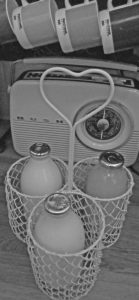
We recently switched from plastic to glass milk bottles simply by getting a milkman (the term here being correct: ours is a bloke). It’s something we had been thinking about for a while, and when a service became available in our area (you can do a postcode check here) we signed up – for a delivery and a Direct Debit.
Milk delivered to the door used to be the norm when Mat and I were kids. In 1980, 89% of all milk consumed by British households arrived in that manner.1 But in much the same way he seems to be the only one in his class who has any idea what a cassette is, Geno is also unusual in that his milk arrives care of one of the 5,000 milk men and women who deliver every day to around 2.5 million British homes, according to Dairy UK.
So, three times a week, milk and freshly-squeezed orange juice in glass bottles appear on the doorstep, well in our milk bottle holder (pictured), much to the delight of a certain six-year-old.
We’ve noticed three things as a result: 1) There’s more room in the red recycling crate 2) We seem to be using less milk – good, as we are trying to reduce dairy 3) We’re using up what we buy.
WRAP reckons milk is the third most wasted product in the UK. We waste 290,000 tonnes of the white stuff a year and it makes up almost 60% of all the dairy and eggs that end up in the bin (or down the drain). All 290,000 tonnes are ‘avoidable’ or in other words, perfectly good.
One of the main reasons for wasting food and drink is not using it in time, meaning we chuck it away because it has either gone off or beyond the date on the packaging. Just under half of all avoidable food and drink waste – worth £5.6 billion – ends up in the bin for this reason, and includes huge quantities of bread, milk (160,000 tonnes of it costing £160 million) and potatoes.
If your household isn’t getting through its milk before it goes off, I have a few pieces of advice:
- Try buying a bit less. You might not be getting through it because you’re buying too much. Perhaps someone has changed the amount they drink, by giving up tea or coffee or switching to a plant-based alternative? We are creatures of habit and tend to do what we’ve always done, so it’s worth a sense-check. If you’re worried about running out, why not buy two smaller containers instead of one big one? You can freeze the other in case it’s needed.
- You can freeze milk? Yup. And there are a couple of ways to do it. It’s not practical to freeze the huge containers. Most domestic freezers just don’t have the space, and it would take an (ice) age to defrost in the fridge, which is the best way of thawing food/drink. But, you can freeze smaller containers successfully. It’s important to take some out before you do – drink a bit or make a cup of tea – to allow room for the milk to expand as it freezes. Forgetting this crucial step could lead to the container rupturing and a certain amount of crying over split/spilt milk.
- Make milk cubes. Ice cube trays are brilliant for freezing small quantities of, well, all sorts of stuff, including milk. Simply fill the tray up as you would for ice cubes and freeze. You can pop the resulting milk cubes straight into your tea or coffee, which should be enough to get you going in the morning should you need to pop to the shop to pick up a pinta.
- Check your fridge temperature. It should be somewhere between 0 and 5 degrees. Every degree over the recommended 5C can wipe off a day of product life, meaning your food could be ‘going off’ much quicker than it should be. Having put this to the test by checking with a thermometer, 5C feels surprisingly cold, but it certainly seems to keep food fresher for longer.
A note on recycling: Here, plastic milk containers are usually made from high-density polyethylene (HDPE) and are widely recycled in the UK. However, moving from plastic containers to rinse-and-return is a move up the waste hierarchy – from recycling to re-use. Funnily enough, our milk man doesn’t take back the glass juice bottles, so they go into the recycling crate (glass is 100% recyclable and can be endlessly reprocessed with no loss of quality) and the milk bottles are returned to be used again and again.
Having said that, we have just tried making Oat Milk from scratch using this method. We now keep a couple of juice bottles handy to contain it!
